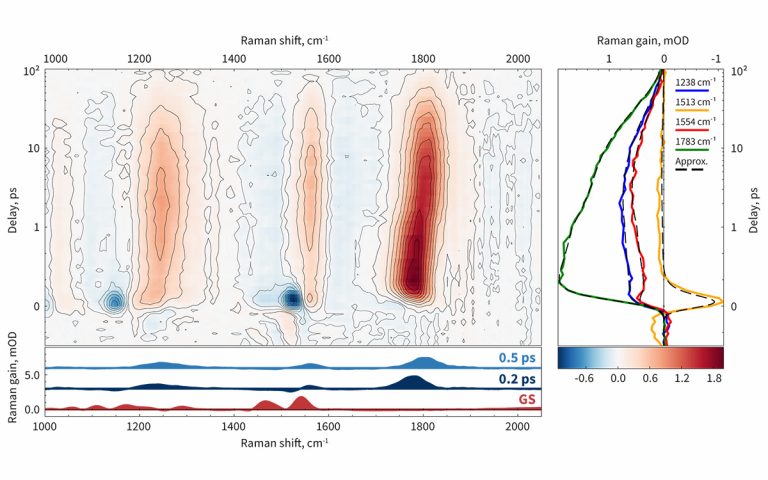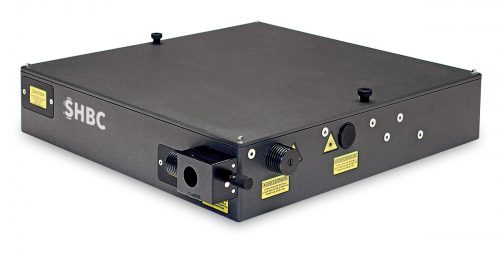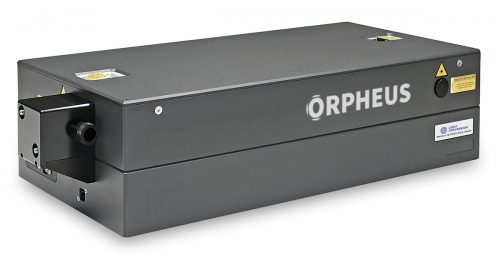Femtosecond stimulated Raman spectroscopy (FSRS) is a relatively recent yet moderately widespread time-resolved spectroscopy technique for observing changes in the vibrational structure of optically excited molecular systems.
At its core, FSRS is a multi-pulse technique that can be summarized as follows. First, an ultrashort actinic pump pulse acts on a molecular system in its ground state and initiates the photoreaction. Then, a pair of temporally delayed pulses probes the successive photoevolution. Here, a picosecond Raman pump and broadband femtosecond Raman probe pulse are used. The temporal overlap of these two pulses brings coherence in the excited state, resulting in the amplification of the Stokes and anti-Stokes frequencies within the probe field, i.e., stimulated Raman emission. Since a high degree of coherence is achieved only during the short temporal overlap of the Raman pump and probe pulses, FSRS spectroscopy offers a high resolution in both spectral and temporal domains.
FSRS is readily available in the HARPIA spectroscopy system, providing vibrational structural information with < 200 fs temporal and < 10 cm-1 spectral resolution. Raman pump can be generated using SHBC, if a fixed-wavelength output at 515 nm is sufficient, or SHBC together with ORPHEUS-PS, if a wide tuning range is desired. The system is pumped by a PHAROS femtosecond laser.
- 515 nm 输出
- 飞秒泵浦可输出皮秒脉冲
- 带宽 < 10 cm-1 或 < 2 cm-1
- 占地面积小
- 飞秒泵浦的皮秒脉冲
- 2100 – 4800 nm 可调波长
- 800 fs – 3 ps 脉宽
- < 20 cm-1 光谱带宽
- 高达 100 kHz 的重复频率
- 高稳定性输出
- 190 nm – 16000 nm 可调波长
- 满足所有需求的高能量和高功率型号
- 单脉冲 – 2 MHz 重复频率
- 最高泵浦功率 80 W
- 最大泵浦单脉冲能量 2 mJ
- 100 fs – 20 ps 连续可调脉宽
- 最大单脉冲能量 4 mJ
- 最小脉宽输出 < 100 fs
- POD 和 BiBurst 功能
- 高达 5 次谐波或可调谐扩展
- CEP 稳定或重复频率锁定
- 热稳定性和密封设计
Spontaneous versus Stimulated Surface-Enhanced Raman Scattering of Liquid Water
P. Filipczak, M. Pastorczak, T. Kardaś, M. Nejbauer, C. Radzewicz, and M. Kozanecki, The Journal of Physical Chemistry C 3 (125), 1999-2004 (2020).
Incoherent phonon population and exciton-exciton annihilation dynamics in monolayer WS2 revealed by time-resolved Resonance Raman scattering
S. Han, C. Boguschewski, Y. Gao, L. Xiao, J. Zhu, and P. H. M. van Loosdrecht, Optics Express 21 (27), 29949 (2019).
A tunable time-resolved spontaneous Raman spectroscopy setup for probing ultrafast collective excitation and quasiparticle dynamics in quantum materials
R. B. Versteeg, J. Zhu, P. Padmanabhan, C. Boguschewski, R. German, M. Goedecke, P. Becker, and P. H. M. van Loosdrecht, Structural Dynamics 4 (5), 044301 (2018).
Exciton and phonon dynamics in highly aligned 7-atom wide armchair graphene nanoribbons as seen by time-resolved spontaneous Raman scattering
J. Zhu, R. German, B. V. Senkovskiy, D. Haberer, F. R. Fischer, A. Grüneis, and P. H. M. van Loosdrecht, Nanoscale 37 (10), 17975-17982 (2018).
Selective suppression of CARS signal with three-beam competing stimulated Raman scattering processes
D. S. Choi, B. J. Rao, D. Kim, S. Shim, H. Rhee, and M. Cho, Physical Chemistry Chemical Physics 25 (20), 17156-17170 (2018).
Selective Suppression of Stimulated Raman Scattering with Another Competing Stimulated Raman Scattering
D. Kim, D. S. Choi, J. Kwon, S. Shim, H. Rhee, and M. Cho, The Journal of Physical Chemistry Letters 24 (8), 6118-6123 (2017).
A tunable femtosecond stimulated Raman scattering system based on spectrally narrowed second harmonic generation
K. Redeckas, V. Voiciuk, and M. Vengris, Lithuanian Journal of Physics 1 (56) (2016).
Structural Heterogeneity in the Localized Excited States of Poly(3-hexylthiophene)
W. Yu, T. J. Magnanelli, J. Zhou, and A. E. Bragg, The Journal of Physical Chemistry B 22 (120), 5093-5102 (2016).





